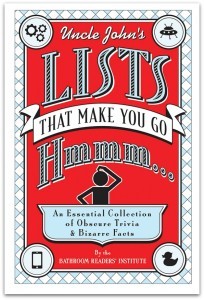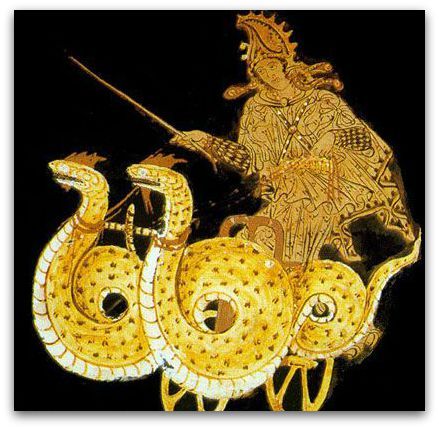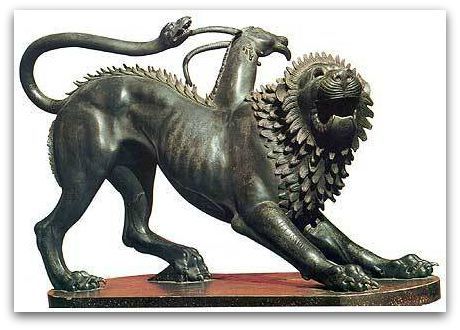Bathroom Readers' Institute's Blog, page 103
September 2, 2015
10 Dragons from Greek Mythology
Better known as the Kraken from Clash of the Titans, it was going to eat Andromeda (chained to a rock as a sacrifice) until Perseus saved her.
Python
Guarded the Oracle of Delphi’s shrine, killed by Apollo.
Hesperios
The guard dragon of the Golden Apples. After Heracles slew it, the gods placed it in the heavens to become the constellation Draco.
Drakones of Medea
Two flying dragons that pulled the witch Medea’s chariot.
Chimera
A lion’s body with a dragon’s tail and a goat head on its back, slain by Bellerophon.
Campe
This winged serpent was a woman from the waist up. Her feet were 1,000 vipers, and the heads of 50 animals protruded from her waist. Guarded the prison pit of Tartaros.
Kholkikos
This unsleeping dragon guarded the Golden Fleece until it was slain by the hero Jason.
Thespiakos
To save his city, Menestratos wore a breastplate covered in hooks and let Thespiakos eat him; the hooks slew the beast from within.
Kykhreides
Terrorized the island of Salamis until Kykhreus drove it away. Then it fled to the goddess Demeter and became her companion.
Hydra
When Heracles tried to remove her nine heads, two more popped up for every one he chopped off. So he cauterized the neck stumps so they couldn’t regenerate and kept hack, hack, hacking away until Hydra was dead.
This article was first published in Uncle John’s Lists that Make You Go Hmmm . . .

The post 10 Dragons from Greek Mythology appeared first on Trivia Books and Facts | Uncle John's Bathroom Reader.
September 1, 2015
Record Breakers In Any Other Year
Good news: you’re one of the greatest athletes of all time! Bad news: you peaked in the same year as someone just a little bit better.
 Roger Maris set the single-season home run record of 61 in 1961, a record that would stand for more than 35 years. In 1998, Mark McGwire and Sammy Sosa battled each other to break Maris’s record…and both did. Sosa’s 66 obliterated Maris’s 61, and he would’ve held the single-season record had he played in any other season. That’s because McGwire finished the season with 70. (Barry Bonds would hit 73 just three years later…and, along with McGwire and Sosa, was linked to performance-enhancing drugs.)
Roger Maris set the single-season home run record of 61 in 1961, a record that would stand for more than 35 years. In 1998, Mark McGwire and Sammy Sosa battled each other to break Maris’s record…and both did. Sosa’s 66 obliterated Maris’s 61, and he would’ve held the single-season record had he played in any other season. That’s because McGwire finished the season with 70. (Barry Bonds would hit 73 just three years later…and, along with McGwire and Sosa, was linked to performance-enhancing drugs.)Sham was one of the fastest thoroughbred racehorses of all time. He could’ve even won horse racing’s Triple Crown…had he not had the misfortune of competing the same year as Secretariat, the fastest and most famous racehorse of the 20th century, if not all time. Sham finished second in the Kentucky Derby with a time of under two minutes, a feat not equaled until 2001, not counting the slightly better time of the horse that beat him, Secretariat. In the next branch of the Triple Crown, Sham again finished second (behind Secretariat). And at the Belmont Stakes, Sham burst out to a quick lead, only to lose once again to Secretariat.
In baseball, the lower a pitcher’s ERA or earned run average, the better he’s doing—allowing fewer runners to score. Rarely does a pitcher’s ERA fall below 2.0, but in 1968, pitchers in both leagues threw their way to historically low levels. Luis Tiant of the Cleveland Indians finished the season with an ERA of 1.603, the lowest since Eddie Cicotte got to 1.532 in 1917. But Bob Gibson of the St. Louis Cardinals achieved an even lower ERA that same season: 1.123, the lowest ever in baseball’s modern age (a record that still stands).
The post Record Breakers In Any Other Year appeared first on Trivia Books and Facts | Uncle John's Bathroom Reader.
August 27, 2015
Join the Dark Side: We’ll Silence Your Bullies
A Star Wars fan club named itself after a coalition of bad guys aligned with Darth Vader. But they’re bringing some real goodness to the world.

In 2010, a suburban Chicago 7-year-old named Katie Goldman proudly took a Star Wars water bottle to school until she abruptly asked her mother for a pink one instead. Why the sudden switch? The boys at school told her that Star Wars was only for boys. Her mother, Carrie, wrote about the situation on her blog—Katie is adopted, and the blog is about parenting adopted children. The post went viral, and before long, other Star Wars fans told Katie not to back down. A toy company sent her a lightsaber; one of the voices from the Star Wars: The Clone Wars TV show called her; and LucasFilm, the makers of Star Wars, sent her a bunch of Star Wars stuff…which Katie shared with her bullies. Best of all, a Star Wars fan club called the 501st Legion, which specializes in wearing Star Wars costumes from the Empire side—Darth Vader, Stormtroopers, etc., sent Katie a pint-sized stormtrooper outfit.
In 2014, Katie got an email from the 501st Legion. They told her another girl was being bullied for liking Star Wars. Katie had outgrown the Stormtrooper costume, so it was sent along to the next recipient, Allison.
Earlier this month, a Virginia elementary school-age girl named Layla wore her R2-D2 jacket to school. She’s a big fan of Star Wars, and wanted to show her pride. But the boys at her school told her that she couldn’t and shouldn’t like Star Wars, because it was for boys only. She became the latest recipient of the Stormtrooper costume, courtesy of the 501st Legion.
The post Join the Dark Side: We’ll Silence Your Bullies appeared first on Trivia Books and Facts | Uncle John's Bathroom Reader.
7 Fun Facts About the MTV Video Music Awards
The VMAs are held tonight, so here are some fun facts.
Only two musicians have won the award for Video of the Year award more than once: Eminem and Rihanna. The former won in 2000 and 2002 for “The Real Slim Shady” and “Without Me,” and the latter won for “Umbrella” and “We Found Love” in 2007 and 2012.
Only one-hit-wonder to win the Video of the Year award: Jamiroquai, for “Virtual Insanity” (1997).
Aimee Mann and Michael Penn are the only married couple to both win Best New Artist at the VMAs. Mann won in 1985 with her group ‘Til Tuesday, and Penn won in 1990.
There are dozens of categories in that other big music awards show, the Grammys. One of the more obscure ones is for Best Music Video. There is very little overlap with Video of the Year winners. In 30 years, only five videos have won both the Grammy and the VMA: Eminem’s “Without Me,” Lady Gaga’s “Bad Romance,” Madonna’s “Ray of Light,” R.EM.’s “Losing My Religion,” and Rihanna’s “We Found Love.”
There are 17 current categories at the Video Music Awards, with 29 other retired over the years. Among the more dated of those discontinued awards: Best Artist Website, Best Video Game Soundtrack, and Ringtone of the Year.
The award for Quadruple Threat of the Year was given out just once, in 2007, to Justin Timberlake.
The VMA equivalent of the “lifetime achievement award” is the Michael Jackson Video Vanguard, named for the pop star who helped elevate early music videos to an art form with clips like “Thriller” and “Beat It.” In 2002, however, Michael Jackson thought he was being given an even greater award: “Artist of the Millennium.” That award doesn’t exist. What happened is that the VMAs coincided with Jackson’s 44th birthday, and he was in attendance. Britney Spears came out on stage with a special trophy, wished Jackson a happy birthday, and casually referred to him as the “artist of the millennium.” Jackson came out and delivered a speech about how honored he was to be named MTV’s “artist of the millennium.” Except that he wasn’t. He was just being wished a happy birthday.
The post 7 Fun Facts About the MTV Video Music Awards appeared first on Trivia Books and Facts | Uncle John's Bathroom Reader.
August 26, 2015
Ask Uncle John Anything: These Words are Crazy!
Uncle John knows pretty much everything—and if he doesn’t, he heads his massive research library, or puts one of his many associates on the case. So go ahead: In the comments below, ask Uncle John anything. (And if we answer your question sometime, we’ll send you a free book!)
How did “nuts” or “bananas” come to mean “crazy”?
 The English language has long had a flippant attitude toward mental illness. Any sort of abnormal behavior can get you called crazy. And if you actually are crazy, in other words, mentally ill, it’s not very nice when people call you crazy. That’s created a lot of light-hearted synonyms for crazy or weird or not quite right. Here’s how a few of them developed.
The English language has long had a flippant attitude toward mental illness. Any sort of abnormal behavior can get you called crazy. And if you actually are crazy, in other words, mentally ill, it’s not very nice when people call you crazy. That’s created a lot of light-hearted synonyms for crazy or weird or not quite right. Here’s how a few of them developed.
Nuts
By the middle of the 19th century, it was common slang to refer to one’s head as a nut. It makes sense—the head is round, like a nut, and the important stuff is all encased in a thick, protective shell (your skull). Etymologists say that around 1860, the phrase “to be off one’s nut” came into common usage, and it meant insane—if you were off your nut, you were out of your head. (Similarly, nutter is British slang for an insane person). But “off one’s nut” didn’t become the much shorter, simpler “nuts” until the 1930s, thereby dropping all of the head-and-nut imagery.
Bananas
This one comes from a long series of corruptions and adaptations of slang use of the word “bent.” In the 1910s, bent was criminal slang that meant “crooked” (used by criminals who thought other criminals were crooked). By the 1930s, it had evolved to mean illegal, in general. From there, somebody started saying “bananas” instead of bent, because bananas are crooked. It’s a quick step from crooked to just plane crazy, and that’s what happened when the word was used in the popular 1930s crime slang book The Underworld Speaks. It was published by the FBI to help average people spot gangsters by their slang.
The post Ask Uncle John Anything: These Words are Crazy! appeared first on Trivia Books and Facts | Uncle John's Bathroom Reader.
The Forbidden Areas of Disney World
Walt Disney World is roughly the size of San Francisco, so it’s not surprising that there are a few places within its borders that are strictly off-limits to guests.
Discovery Island
 Originally named Treasure Island, guests were once able to view its population of animals and plants, and was closed in 1999 when the animals were relocated to the Animal Kingdom theme park. Disney’s “Imagineers” considered turning the island into an attraction inspired by the popular video game Myst but the idea never made it past the conceptual stage. Plans to build an attraction based on the hit TV show Lost suffered the same fate a decade later. Currently, Discovery Island is considered abandoned with no plans for its renovation. However, a group of brave Disney fans managed to sneak onto the island in the 2000s.
Originally named Treasure Island, guests were once able to view its population of animals and plants, and was closed in 1999 when the animals were relocated to the Animal Kingdom theme park. Disney’s “Imagineers” considered turning the island into an attraction inspired by the popular video game Myst but the idea never made it past the conceptual stage. Plans to build an attraction based on the hit TV show Lost suffered the same fate a decade later. Currently, Discovery Island is considered abandoned with no plans for its renovation. However, a group of brave Disney fans managed to sneak onto the island in the 2000s.
Disney’s River Country
This Huckleberry Finn-inspired water park was the resort’s first, and it opened in 1976. River Country had numerous problems with water quality because its source was nearby Bay Lake, and ‘70s-era filtration systems weren’t powerful enough to clean the water effectively. In 1980, a guest contracted an amoeba-carried disease called Naegleria fowleri from the ride and died. Attendance declined, and a new Florida law that banned theme parks from using unchlorinated water from natural sources led to the permanent closer of River Country in 2001. Many of its buildings and features are still standing. Planning to go for a swim? Don’t do it. Security guards patrol the grounds 24/7 in order to prevent guests from trespassing.
The Laundry Building
Given Orlando’s humid climate, Disney World’s immense workforce (about 60,000 employees) tends to work up an enormous amount of sweat. That’s just one of the reasons why the resort has a large building devoted solely to cleaning all of their uniforms and costumes. Disney World currently uses around 2,500 different outfits and Mickey Mouse alone has over 300 different ones. This works out to around 1.8 million different articles of clothing. The original laundry building eventually couldn’t handle the immense task of keeping everything clean so a new one opened last spring. It’s off-limits to guests…but would you really want to visit it?
The post The Forbidden Areas of Disney World appeared first on Trivia Books and Facts | Uncle John's Bathroom Reader.
August 25, 2015
Daily Fun Facts: Shrimps
Today’s daily fun facts include a few little shrimp facts. Enjoy!
 Shrimp exist in a dazzling array of shapes, sizes, and colors. They comprise 2,000 species and are found in deep ocean waters, shallow tidal waters, and freshwater, in every region of every continent but Antarctica.
Shrimp exist in a dazzling array of shapes, sizes, and colors. They comprise 2,000 species and are found in deep ocean waters, shallow tidal waters, and freshwater, in every region of every continent but Antarctica.
They are arthropods—the shelled, segmented phylum that includes all insects, arachnids, and crustaceans. More specifically, shrimp are part of the order Decapoda. All decapods have ten legs, a trait shrimps share with their cousins—crabs and lobsters.
Large shrimp are often called prawns, and vice versa. While they look very much alike, shrimp are more closely related to crabs and lobsters than they are to prawns. Prawns differ in that they have three pairs of pincers rather than a shrimp’s two, they don’t have a pronounced abdomen bend, and they don’t “brood” their eggs—females release them right into the water.
Shrimp are primarily swimmers, not crawlers.
“Cleaner shrimp” survive by eating parasites and dead tissue off of other creatures. Many of these shrimp species live in coral reefs, where they hang out at what biologists call “cleaning stations”— places where fish, sea turtles, and eels go to be nibbled clean.
Shrimp can breed only after a female molts. A male deposits sperm on a female’s underbelly. The female releases eggs (25,000 to a million at a time), which pass through the sperm and are fertilized. She carries the eggs on hairlike structures on her legs, where they’re protected by the shell that soon regrows. Weeks later, the tiny hatchlings are dispersed into the water.
While most shrimp species live from 9 to 18 months, some, such as the North Atlantic shrimp, live to eight years.
This story was originally published in Uncle John’s Fully Loaded 25th Anniversary Bathroom Reader.
The post Daily Fun Facts: Shrimps appeared first on Trivia Books and Facts | Uncle John's Bathroom Reader.
August 20, 2015
14 Facts You Should Know About the Muppet
With the upcoming
The Muppets
reboot, we bring you some interesting facts you should know about the Muppets. “It’s time to put on makeup. It’s time to light the lights. It’s time to get things started with some Muppet facts tonight.” 
1. Disney bought the Muppets in 2003, but only the “classic Muppets” (the ones from The Muppet Show and the Muppet movies). Sesame Street characters are owned by the Sesame Workshop, and the Fraggles are owned by the Jim Henson Company.
2. In Portugal, Kermit the Frog is named “Cocas.” In Spain, he’s “Gustavo.”
 3. The two hecklers in the balcony on The Muppet Show are named Statler and Waldorf. Statler is the one with the grey hair; Waldorf is the one with the mustache. (Waldorf’s wife is named “Astoria.”)
3. The two hecklers in the balcony on The Muppet Show are named Statler and Waldorf. Statler is the one with the grey hair; Waldorf is the one with the mustache. (Waldorf’s wife is named “Astoria.”)
4. Until 1983, HBO aired only movies and sports. Its first show was Fraggle Rock.
5. Telly initially had dazed eyes and a TV antenna on his head. Ironically, during the first few seasons of Sesame Street, he was supposed to warn children that they shouldn’t watch too much TV.
6. An early draft of the screenplay for The Muppet Movie included a recurring role for Secretary of State Henry Kissinger. He was supposed to appear several times, disguised as a sheriff, a busboy, an extra, and as a head on Mount Rushmore.
7. The Muppet characters’ frames are made out of flexible polyfoam (foam rubber isn’t used because it disintegrates). The “skin” is made out of a synthetic material called antron fleece, which is furry, dyeable (very important), and doesn’t get fuzzballs.
8. Miss Piggy’s full, original name was Miss Piggy Lee.
9. The protoype of Kermit was a lizard made from cardboard and covered in material cut from Henson’s mother’s fuzzy green coat. The eyes were two halves of Wacky Stacks, a 1970s line of toy plastic eggs. (When the manufacturer went out of business, Henson bought their entire stock so he’d have Muppet eyes forever.)
10. Two Muppet-sung songs made the pop chart: “Rubber Duckie,” by Sesame Street’s Ernie, hit #16 in 1970, and “Rainbow Connection,” by Kermit the Frog, reached #25 in 1979.
11. The first season of Saturday Night Live featured regular Muppet sequences. New characters from “The Land of Gorch” were created for the show, including “King Ploovis,” “Queen Peuta” (she has three feet), and “The Mighty Favog.” The adult-oriented sketches weren’t very popular with audiences or the writers, and were discontinued in early 1976.
12. Meep! Meep! In more than 30 years, Beaker from The Muppet Show has spoken only three lines: “Sadly, temporary,” “Makeup ready,” and “Bye-bye!”
13. In 2005 Kermit the Frog was given the key to the city of Kermit, Texas.
14. Oscar the Grouch around the world: In Pakistan, he’s “Akhtar” and lives in an oil drum. In Turkey, he’s called “Kirpik” and resides in a basket. There is no Oscar in the Israeli version of Sesame Street. Instead they have Oscar’s cousin, “Moishe Oofnik,” who lives in an abandoned car.
This story was originally published in Uncle John’s Fully Loaded 25th Anniversary Bathroom Reader.
The post 14 Facts You Should Know About the Muppet appeared first on Trivia Books and Facts | Uncle John's Bathroom Reader.
Ask Uncle John Anything: It Glows in the Dark!
Uncle John knows pretty much everything—and if he doesn’t, he heads his massive research library, or puts one of his many associates on the case. So go ahead: In the comments below, ask Uncle John anything. (And if we answer your question sometime, we’ll send you a free book!)
How do those glow-in-the-dark light sticks work?
 Summertime is glow stick (or light stick) season—it’s fun to wave them around at night, at parties, during those Fourth of July celebrations, at the campground, etc. But how do those little day-glo sticks glow (at night) without a battery or a bulb?
Summertime is glow stick (or light stick) season—it’s fun to wave them around at night, at parties, during those Fourth of July celebrations, at the campground, etc. But how do those little day-glo sticks glow (at night) without a battery or a bulb?
Each thin plastic tube is filled primarily with a solution of phenyl oxalate ester and a florescent dye (different dyes allow for different colors of glow stick). Also inside are tiny, fragile glass vials filled with another chemical, a hydrogen peroxide solution. That solution is called an activator, and you activate the glow stick by “cracking” the stick, which is breaking the vials.
This instantly mixes the hydrogen peroxide with the phenyl oxalate ester and dye. Ready for some big words? A chemical reaction called chemiluminescence takes place, converting those solutions into light energy. The hydrogen peroxide oxidizes the phenyl oxalate, creating a chemical called phenol, along with a peroxyacid ester. That ester is unstable, so it rapidly decomposes, giving off a cyclic peroxy compound…which itself decomposes into carbon dioxide, releasing energy to the dye. Electrons in that dye are activated and release energy in the form of light. All of this happens in a fraction of a second.
Ever wonder why people put glow sticks in the freezer to make them last longer? Cold slow down the rate of the chemical reaction, so they burn slower. (If you were to put them in hot water, it would speed up reaction and make the glow stick burn out faster.)
The post Ask Uncle John Anything: It Glows in the Dark! appeared first on Trivia Books and Facts | Uncle John's Bathroom Reader.
August 19, 2015
Trivia Facts About the Goodyear Blimp
No major sporting event is complete without it. In fact, it’s probably the best known lighter-than-air ship ever (except maybe the Hindenburg, which is famous for blowing up). Here are some trivia facts about the Goodyear blimp.
Non-Stick Plans
 In 1809 Charles Goodyear, a hardware merchant from Connecticut, saw that rubber had tremendous commercial potential—but only if it could be made less sticky and would hold a shape better than it already did.
In 1809 Charles Goodyear, a hardware merchant from Connecticut, saw that rubber had tremendous commercial potential—but only if it could be made less sticky and would hold a shape better than it already did.
So he obtained a large quantity of latex and tried mixing it with everything in his desk, cellar, and pantry—including witch hazel, ink, and cream cheese—with no luck. One day he tried mixing rubber with sulfur. Then, while working on something else, he accidentally knocked the sulfurized rubber mixture onto a hot stove.
 He found that the rubber had changed form: it was no longer sticky and it snapped back to its original shape when stretched. He named the process “Vulcanizing” after Vulcan, the Roman god of fire.
He found that the rubber had changed form: it was no longer sticky and it snapped back to its original shape when stretched. He named the process “Vulcanizing” after Vulcan, the Roman god of fire.
Goodyear didn’t get rich from his discovery—he died penniless in 1860. But when Frank A. Seiberling started a rubber company in Akron, Ohio, in 1898, he decided to name it after the inventor.
It’s likely he hoped to profit from the confusion created by having a name similar to another Akron rubber company, B.F. Goodrich.
Goodyear’s first products were bicycle and horse carriage tires, rubber pads for horseshoes, rubber bands, and poker chips. The company produced its first auto tires in 1901, airplane tires in 1909, and, using a Scottish process for rubberized fabric, the skins for airplanes in 1910. (This was back when airplanes were based on kite designs and made mostly of wood and cloth.)
The same rubberized fabric turned out to be useful for lighter than air craft, and Goodyear flew its first dirigible in 1922.
The Military Connection
 The military used Goodyear blimps for observation and reconnaissance during World Wars I and II. After World War II, Goodyear bought five of its blimps back from the armed forces, painted them, and began using them for promotional purposes. But the company’s executives didn’t see the value of having blimps. In 1958 they tried to ground the airships permanently, to save the operating and maintenance expenses.
The military used Goodyear blimps for observation and reconnaissance during World Wars I and II. After World War II, Goodyear bought five of its blimps back from the armed forces, painted them, and began using them for promotional purposes. But the company’s executives didn’t see the value of having blimps. In 1958 they tried to ground the airships permanently, to save the operating and maintenance expenses.
The plan was stalled at the last minute by a plea from Goodyear’s publicity director, Robert Lane. To demonstrate the blimps’ worth to the company, he scheduled a six-month marathon tour that sent the airship Mayflower barnstorming the eastern seaboard. It generated so much favorable press that the executives were convinced to keep it.
The blimps’ first TV coverage was an Orange Bowl game in the mid-1960s. Now they’re used in about 90 televised events a year. Goodyear doesn’t charge TV networks; the publicity generated makes the free service worthwhile.
 Blimp Facts
Blimp Facts Each blimp is equipped with a crew of 23, consisting of 5 pilots, 17 support members who work on rotating schedules, and a publicrelations representative. The blimps cruise at a speed of 45 to 50 mph (a maximum of 65 mph unless there’s a really good wind).
Each blimp can carry nine passengers along with the crew. The seats have no seat belts.
The camera operator shoots from the passenger compartment through an open window from about 1,200 feet up, from which you can see everything, read a scoreboard, and hear the roar of a crowd. The hardest sport to film is golf, because the pilots have to be careful not to disturb a golfer’s shot with engine noise or by casting a sudden shadow over the green.
If punctured, the worst that will happen is that the blimp will slowly lose altitude. Good thing, too, since the company reports that a blimp is shot at about 20 times a year.
Each blimp is 192 feet long, 59 feet high, and holds 202,700 cubic feet of helium. The helium does leak out, like a balloon’s air, and has to be “topped off” every four months or so.
The word blimp is credited to Lt. A. D. Cunningham of Britain’s Royal Navy Air Service. In 1915 he whimsically flicked his thumb against the inflated wall of an airship and imitated the sound it made: “Blimp!”
Story was first published in Uncle John’s Sports Spectacular.
The post Trivia Facts About the Goodyear Blimp appeared first on Trivia Books and Facts | Uncle John's Bathroom Reader.













